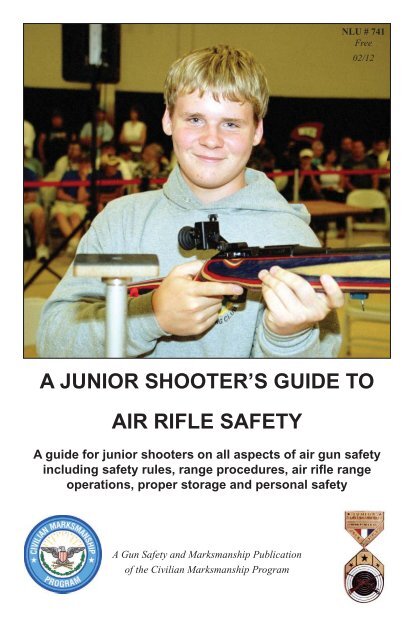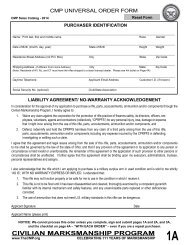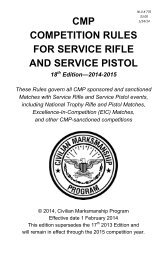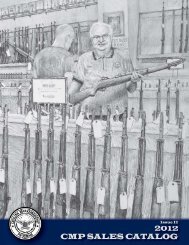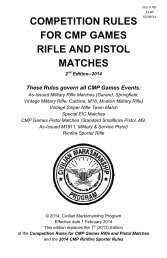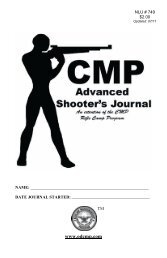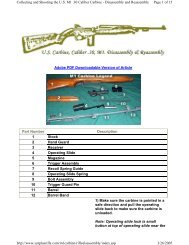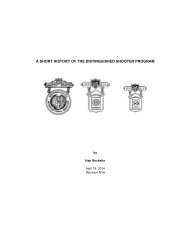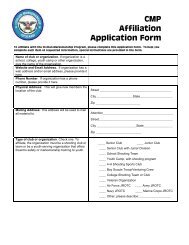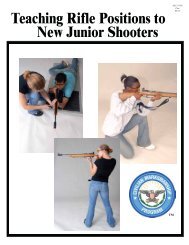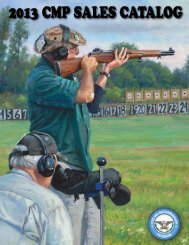Jr Shooter's Guide to Air Rifle Safety - Civilian Marksmanship Program
Jr Shooter's Guide to Air Rifle Safety - Civilian Marksmanship Program
Jr Shooter's Guide to Air Rifle Safety - Civilian Marksmanship Program
Create successful ePaper yourself
Turn your PDF publications into a flip-book with our unique Google optimized e-Paper software.
NLU # 741<br />
Free<br />
02/12<br />
A JUNIOR SHOOTER’S GUIDE TO<br />
AIR RIFLE SAFETY<br />
A guide for junior shooters on all aspects of air gun safety<br />
including safety rules, range procedures, air rifle range<br />
operations, proper s<strong>to</strong>rage and personal safety<br />
A Gun <strong>Safety</strong> and <strong>Marksmanship</strong> Publication<br />
of the <strong>Civilian</strong> <strong>Marksmanship</strong> <strong>Program</strong>
This <strong>Guide</strong> is endorsed by the<br />
National Three-Position <strong>Air</strong> <strong>Rifle</strong><br />
Council. Council Members are:<br />
The American Legion<br />
Boy Scouts of America<br />
<strong>Civilian</strong> <strong>Marksmanship</strong> <strong>Program</strong><br />
Daisy/U. S. Jaycees Shooter<br />
Education <strong>Program</strong><br />
National 4-H Shooting Sports<br />
U.S. Army <strong>Marksmanship</strong> Unit<br />
USA Shooting<br />
The Army, Marine Corps, Navy and<br />
<strong>Air</strong> Force JROTC Commands
© 2012 by the <strong>Civilian</strong> <strong>Marksmanship</strong> <strong>Program</strong>.<br />
<strong>Guide</strong> <strong>to</strong> <strong>Air</strong> Rifl e <strong>Safety</strong><br />
Page 1<br />
All rights reserved. Except for use in a review, no part of this publication may<br />
be reproduced or transmitted in any form or by any means, electronic or mechanical,<br />
including pho<strong>to</strong>-copy, recording, or any other information s<strong>to</strong>rage<br />
and retrieval system, without the written permission of the CMP.<br />
This guide is a gun safety publication of the <strong>Civilian</strong> <strong>Marksmanship</strong> <strong>Program</strong>.<br />
The guide was written by Gary Anderson, Direc<strong>to</strong>r of <strong>Civilian</strong> <strong>Marksmanship</strong>,<br />
but it benefi ted from the advice and experiences of numerous junior shooting<br />
leaders who have taught gun safety and marksmanship and supervised<br />
range fi ring and competition activities for thousands of junior shooters. The<br />
CMP acknowledges and thanks each of these experts who contributed <strong>to</strong><br />
the guide and reviewed guide copy prior <strong>to</strong> its publication. The CMP acknowledges,<br />
in particular, the review comments and guidance received from<br />
representatives of organizations that belong <strong>to</strong> the National Three-Position<br />
<strong>Air</strong> Rifl e Council and from numerous JROTC <strong>Marksmanship</strong> Instruc<strong>to</strong>rs.<br />
The information in this guide was carefully researched and evaluated by<br />
expert marksmanship instruc<strong>to</strong>rs and leaders. All reasonable efforts were<br />
made <strong>to</strong> ensure that the safety guidance and procedures described in the<br />
guide represent a consensus of experts as <strong>to</strong> the best, most effective and<br />
most thoroughly tested safety rules, procedures and guidelines that can be<br />
applied in any situation involving air rifl e handling or target range fi ring.<br />
The CMP is always happy <strong>to</strong> hear from you. For questions or comments<br />
concerning the edi<strong>to</strong>rial content of this guide, please write <strong>to</strong> CMP <strong>Program</strong>s,<br />
P. O. Box 576, Port Clin<strong>to</strong>n, OH 43452 or via email <strong>to</strong> info@odcmp.com. For<br />
more information about the CMP and its programs and activities for youth<br />
and adults, visit us at www.TheCMP.org.<br />
Author: Gary Anderson, Direc<strong>to</strong>r of <strong>Civilian</strong> <strong>Marksmanship</strong> Emeritus<br />
Printed in the USA<br />
A Junior Shooter’s <strong>Guide</strong> <strong>to</strong><br />
<strong>Air</strong> <strong>Rifle</strong> <strong>Safety</strong><br />
A guide for junior shooters on all aspects of air gun safety<br />
including safety rules, range procedures, air rifle range operations,<br />
proper s<strong>to</strong>rage and personal safety.
<strong>Guide</strong> <strong>to</strong> <strong>Air</strong> Rifl e <strong>Safety</strong><br />
Page 2<br />
SAFE GUN HANDLING RULES<br />
The sport of target rifle shooting is one of the safest of all sports. In 108<br />
years of Olympic Games shooting, there has never been an accidental injury<br />
involving a gun. There are several thousand junior shooting clubs, JROTC<br />
unit rifl e teams, 4-H Shooting Sports clubs, Boy Scout troops and Venturing<br />
crews, youth camps and junior shooting organizations that practice and<br />
compete in position air rifl e shooting and other air rifl e activities. These<br />
programs have more than 100,000 participants in the United States. These<br />
youth marksmanship activities have compiled an outstanding safety record<br />
where gun-related accidents are extremely rare. Rifl e marksmanship activities<br />
are indeed among the safest of all youth sports.<br />
Target shooting established its record as one of the safest of all sports because<br />
everyone in it must learn and follow basic safety rules. Target shooting<br />
is a sport of control and discipline where everyone involved, including<br />
participants, instruc<strong>to</strong>rs, coaches and range offi cers, is expected <strong>to</strong> know<br />
and apply the sport’s safety rules at all times.<br />
Rules for Safe<br />
Gun Handling<br />
Three primary safe gun handling rules<br />
are the foundation for the safe handling<br />
and use of all types of guns, including<br />
the air rifl es that are used in youth<br />
marksmanship programs. These safety<br />
rules focus on three primary parts of every<br />
gun that control when and where the<br />
gun can be fi red. Those parts are the<br />
MUZZLE, ACTION and TRIGGER.
<strong>Guide</strong> <strong>to</strong> <strong>Air</strong> Rifl e <strong>Safety</strong><br />
Page 3<br />
CLEAR BARREL INDICATORS -- CBIs<br />
<strong>Safety</strong> flags are now used in target shooting <strong>to</strong> positively<br />
demonstrate that gun actions are open and barrels or<br />
chambers are unloaded. <strong>Safety</strong> indica<strong>to</strong>rs used for air<br />
rifles are called Clear Barrel Indica<strong>to</strong>rs or CBIs. <strong>Air</strong> rifl e<br />
CBIs are cut from orange or bright-colored weed-eater<br />
cord (.065-.095” dia.) and must be long enough so that<br />
when inserted in the air rifle barrel 4-6 inches of the cord<br />
projects out of both ends of the barrel.<br />
Here are some rules for the proper use of CBIs in air rifl es:<br />
1. Insert CBI before bringing rifl e <strong>to</strong> range or when removing<br />
the rifle from a gun case.<br />
2. Remove CBI only on the firing line after the Range Officer<br />
instructs you <strong>to</strong> handle rifl es and begin preparation<br />
for firing or dry fi ring.<br />
3. When you finish firing, immediately open the action,<br />
ground the rifl e and insert the CBI.<br />
When all firers are finished, the<br />
Range Officer can quickly and<br />
accurately verify that all air rifles<br />
have open actions and empty<br />
barrels by looking for CBIs in<br />
each rifl e on the firing line.<br />
Inserting CBI<br />
<strong>Air</strong> <strong>Rifle</strong> with<br />
CBI inserted
<strong>Guide</strong> <strong>to</strong> <strong>Air</strong> Rifl e <strong>Safety</strong><br />
Page 4<br />
Trigger Action Muzzle<br />
Trigger Guard<br />
Bolt: Open<br />
action by<br />
pulling <strong>to</strong> rear<br />
Loading port and<br />
breech end of barrel<br />
TIP: An easy way <strong>to</strong> remember the Rules for Safe Gun Handling is <strong>to</strong><br />
use the key word MAT. MAT, of course, stands for Muzzle-Action-Trigger.<br />
MAT is also useful because that is the order in which the three<br />
safety rules must be applied. Whenever you handle a rifl e always start<br />
by controlling the muzzle.<br />
Everyone should know the primary parts of a gun, whether or not they will<br />
ever participate in target shooting, so that they can apply the rules for safe<br />
gun handling any time they are in a situation where a gun is present.<br />
MUZZLE. The forward end of the barrel. The muzzle is the point where the<br />
pellet or projectile leaves the barrel when the gun is fi red. A gun is aimed by<br />
pointing its muzzle at the target. Whenever a projectile is fi red, it will strike<br />
exactly where the muzzle is pointed.<br />
ACTION. The working mechanism of the gun. Gun actions typically have<br />
a bolt or cocking lever that is used <strong>to</strong> open and close the action so that the<br />
gun can be loaded and unloaded. A gun cannot ordinarily be fi red unless its<br />
action is closed and locked.<br />
TRIGGER. The trigger is part of the action or working mechanism of the<br />
gun. The trigger is a lever that projects out of the bot<strong>to</strong>m of the action. A trigger<br />
guard protects the trigger. After a gun is loaded and the action is closed,<br />
the gun is fired by pulling or applying pressure <strong>to</strong> the trigger.
Trigger<br />
Action<br />
Muzzle<br />
<strong>Guide</strong> <strong>to</strong> <strong>Air</strong> Rifl e <strong>Safety</strong><br />
Page 5<br />
Many junior shooting programs conduct rifl e marksmanship training<br />
with .22 cal. smallbore rifl es like the one shown here. These rifl es<br />
have bolt actions that are opened by lifting a bolt and pulling it <strong>to</strong> the<br />
rear (see illustration at bot<strong>to</strong>m of this page).<br />
The rules for safe gun handling follow a step-by-step sequence designed<br />
<strong>to</strong> prevent the unintentional fi ring of a gun or <strong>to</strong> assure that even if a gun is<br />
unintentionally fi red, that this does not cause personal injury. Follow these<br />
steps every time you handle a gun:<br />
1. Whenever anyone picks up a gun of any kind, the first thing that must<br />
be done is <strong>to</strong> control the direction the muzzle points. Immediately<br />
point the gun in a safe direction where it is not directed at another person<br />
and would do no serious damage even if the gun were unintentionally<br />
fi red. The fi rst thing <strong>to</strong> do when picking up a gun or when taking a gun<br />
from someone else is <strong>to</strong> point it away from other people in the area. The<br />
safest direction <strong>to</strong> point a gun is usually upward with the muzzle held<br />
above head level. If a gun is on a range, the safest direction is <strong>to</strong> point<br />
it downrange <strong>to</strong>wards the targets.<br />
2. As soon as the gun muzzle is pointing in a safe direction, the second<br />
step is <strong>to</strong> check the action of the gun and <strong>to</strong> open it if it is not<br />
already open. Since the gun’s action contains its fi ring mechanism,<br />
it cannot be fired unintentionally or accidentally if the action is open.<br />
All guns, except muzzle loading<br />
guns, have a bolt or lever on the<br />
action that opens the action. Be<br />
sure <strong>to</strong> learn where the bolt or<br />
cocking lever is on any gun you<br />
handle. With the action open, it<br />
is possible <strong>to</strong> visually check most<br />
guns <strong>to</strong> see whether the gun is<br />
loaded and has a cartridge or pellet<br />
in the breech end (rear end) of<br />
the barrel. If you check a gun ac-<br />
Bolt<br />
Loading Port
<strong>Guide</strong> <strong>to</strong> <strong>Air</strong> Rifl e <strong>Safety</strong><br />
Page 6<br />
Loading Port<br />
Many junior shooting programs have precision air rifl es like this air rifl e<br />
that rifl e team members use in competitions. Pulling, lifting or pushing a<br />
lever on the action opens the loading port and action.<br />
tion and see that the gun is loaded with a cartridge or pellet, the cartridge<br />
or pellet must be removed <strong>to</strong> make the gun safe.<br />
3. With the muzzle pointing in a safe direction<br />
and the action open so that the<br />
gun cannot be fired, the third safety<br />
precaution is <strong>to</strong> hold or carry the<br />
rifle with all fingers held outside of<br />
the trigger guard and not on the trigger.<br />
The trigger guard is a protective<br />
band around the trigger. Its purpose is<br />
<strong>to</strong> protect the trigger from being pulled<br />
unintentionally. By keeping the fi ngers<br />
outside of the trigger guard, it is impossible<br />
<strong>to</strong> accidentally pull the trigger<br />
should the action somehow become<br />
closed.<br />
The index fi nger must remain outside of the trigger<br />
guard at all times until the rifl e is in the fi ring position<br />
and you begin <strong>to</strong> look through the sights and start <strong>to</strong> aim<br />
in preparation for fi ring a shot.
<strong>Guide</strong> <strong>to</strong> <strong>Air</strong> Rifl e <strong>Safety</strong><br />
Page 7<br />
RULES FOR SAFE GUN HANDLING:<br />
1. MUZZLE. Always keep gun muzzles pointed in a safe<br />
direction. Gun muzzles must never be pointed at other<br />
persons under any circumstance. On a range, the safest<br />
directions <strong>to</strong> point a gun muzzle are usually upward<br />
or downrange <strong>to</strong>wards the target.<br />
2. RIFLE ACTION. When handling any rifl e or fi rearm, the<br />
action must be open with a CBI inserted. Gun actions<br />
must remain open except when the gun is on the fi r-<br />
ing line and preparation or fi ring periods have begun.<br />
When shooting is finished, the action must be open and<br />
a CBI must be inserted, even when the gun is on the fi r-<br />
ing line. The gun action may be closed when it is placed<br />
in a gun case or s<strong>to</strong>reroom, but must be opened and a<br />
CBI inserted as soon as it is picked up again.<br />
3. TRIGGER. Keep your fi nger off of the trigger until after<br />
placing the gun in the shooting position and preparing <strong>to</strong><br />
fi re a shot. It is especially important <strong>to</strong> keep the finger<br />
outside of the trigger guard when loading the gun and<br />
placing it in the shooting position.<br />
SHOOTING RANGES<br />
Everyone who comes in contact with a<br />
gun needs <strong>to</strong> know the three basic rules<br />
for safe gun handling. Individuals who use<br />
rifl es in junior marksmanship or other target<br />
shooting activities also need <strong>to</strong> know<br />
and practice additional rules regarding the<br />
safe operation of target shooting ranges.<br />
To understand these safety rules it is fi rst<br />
necessary <strong>to</strong> know something about how<br />
target ranges are designed and laid out.<br />
<strong>Air</strong> rifl e ranges have a fi r-<br />
ing line where the shooters<br />
stand and a row of target<br />
holders and backs<strong>to</strong>ps.
<strong>Guide</strong> <strong>to</strong> <strong>Air</strong> Rifl e <strong>Safety</strong><br />
Page 8<br />
Study the diagram of the range that is shown above so that you understand<br />
how the fi ring points and targets are positioned on a typical range. This<br />
diagram is for a 6-point range, but target ranges can have as few as three or<br />
four and as many as 80 or more fi ring points.<br />
Typical <strong>Air</strong> <strong>Rifle</strong> Range Layout<br />
Range<br />
Offi cer<br />
stand or<br />
table<br />
Firing Line<br />
Exterior wall or<br />
safety barrier<br />
Ready<br />
Line -<br />
not all<br />
ranges<br />
have a<br />
Ready<br />
Line<br />
Distance:<br />
10 meters<br />
Ready Area: For<br />
shooters waiting<br />
<strong>to</strong> fire next or for<br />
specta<strong>to</strong>rs<br />
Firing Points:<br />
One for each<br />
shooter<br />
Target Holders:<br />
One for each<br />
fi ring point
<strong>Air</strong> rifle ranges have these primary features:<br />
<strong>Guide</strong> <strong>to</strong> <strong>Air</strong> Rifl e <strong>Safety</strong><br />
Page 9<br />
<strong>Safety</strong> Barrier. Ranges must have an outside wall or some means<br />
of preventing unauthorized persons from entering the range area<br />
while fi ring takes place. During fi ring, the entire safety barrier forward<br />
of the fi ring line must be secured so that no one can enter<br />
the range from the outside.<br />
Target Holders. At the front end of<br />
the range there are a series of target<br />
holders and backs<strong>to</strong>ps. Most<br />
target holders have a metal plate<br />
behind the targets that serves as<br />
a backs<strong>to</strong>p <strong>to</strong> s<strong>to</strong>p and collect the<br />
pellets that are fired at the targets.<br />
The target holders are designed so<br />
that targets can be hung on them<br />
at heights appropriate for the three<br />
shooting positions. Prone targets<br />
are hung low, standing targets are<br />
placed chest high and kneeling targets<br />
in between.<br />
10-meter air rifl e range target<br />
holders with targets placed<br />
at the proper heights for firing<br />
from the prone, kneeling<br />
and standing positions.<br />
Firing Line. At a distance of exactly 10 meters from the targets,<br />
a fi ring line is marked on the fl oor of the range. The fi ring line<br />
is normally a red or colored stripe or tape that is two or three<br />
inches wide. All shooters must position<br />
themselves on their fi ring points so that no<br />
part of their feet or body <strong>to</strong>uches the back<br />
edge of the fi ring line.<br />
Range Officer. Immediately behind the<br />
line of fi ring points, a table, stand or working<br />
area for the range officer is located.<br />
The Range Officer is in charge of firing<br />
on the range and gives commands<br />
and instructions <strong>to</strong> control shooting.<br />
Range Officers use a standard series<br />
of range commands <strong>to</strong> control the<br />
conduct of all shooting activities.<br />
A Range Offi cer or instruc<strong>to</strong>r<br />
is in charge of the<br />
fi ring on every range. The<br />
commands and instructions<br />
of the Range Offi cer<br />
must always be followed.
<strong>Guide</strong> <strong>to</strong> <strong>Air</strong> Rifl e <strong>Safety</strong><br />
Page 10<br />
Firing Points. The fi ring line is broken in<strong>to</strong> divisions called firing<br />
points. Firing points are rectangular spaces behind the fi ring<br />
line. Firing points are approximately 1 meter wide by 2 meters<br />
long. The width of each fi ring point corresponds <strong>to</strong> the distance<br />
between the targets. Only one shooter may occupy one fi ring<br />
point at one time.<br />
Ready Area. Most ranges also have an area behind the fi ring<br />
line that is designated as a preparation or ready area. If there are<br />
other shooters who are waiting their turn <strong>to</strong> fi re, this is the area<br />
where they should remain. If there are specta<strong>to</strong>rs, this also is the<br />
area where they should stand or sit. Individuals in the Ready Area<br />
must remain in that area and not go forward <strong>to</strong> the fi ring line until<br />
instructed <strong>to</strong> do so by the Range Officer.<br />
SAFE LOADING PROCEDURE<br />
To load an air rifl e while maintaining the highest level of safety,<br />
follow these steps:<br />
1. Start with the bolt (action) open. After firing a shot, always<br />
open the bolt (action) as the first step in loading. Do not<br />
charge an air rifl e with a closed action.<br />
2. Open and close the charging lever <strong>to</strong> charge the rifl e with air.<br />
3. Insert pellet in the loading port or breech end of the barrel.<br />
4. Close the bolt (action).<br />
5. Lift the air rifl e in<strong>to</strong> position <strong>to</strong> prepare <strong>to</strong> fi re the next shot.<br />
Keep the index fi nger on the outside of the trigger guard while<br />
bringing the rifl e in<strong>to</strong> the fi ring position.<br />
No one on the range may charge<br />
and load their air rifl es before the<br />
command LOAD is given. While<br />
charging and loading the air rifl e,<br />
be sure <strong>to</strong> keep the muzzle under<br />
control so that it points upward or<br />
downrange.
<strong>Guide</strong> <strong>to</strong> <strong>Air</strong> Rifl e <strong>Safety</strong><br />
Page 11<br />
SAFETIES<br />
A safety is a mechanical device that blocks the trigger or fi r-<br />
ing mechanism from working when it is engaged (safety is on).<br />
Many air rifles used in junior marksmanship programs have<br />
safeties, but many other target air rifl es do not have safeties.<br />
Safeties are made for general purpose guns where there is<br />
a possibility that a gun may be carried loaded. For example,<br />
hunters use safeties when they carry a loaded rifl e or shotgun<br />
in the field or woods. Safeties are not normally used in target<br />
shooting because the primary ‘safety’ in target shooting is the<br />
open action and the safety fl ag (CBI). More importantly, rifl es<br />
on target ranges are loaded only on the fi ring line and only when<br />
they are <strong>to</strong> be fired at a target so there is never any reason <strong>to</strong><br />
carry a loaded rifl e <strong>to</strong> any other location on a range.<br />
Even though engaging and disengaging the safety is not part<br />
of normal air rifl e loading procedures on target ranges, your<br />
instruc<strong>to</strong>r may wish <strong>to</strong> have you practice with the safety so you<br />
will be familiar with safeties and how they work. If you do this,<br />
you must understand that engaging a safety does not relieve<br />
you of the responsibility for following any rules for safe gun handling.<br />
RANGE COMMANDS<br />
Whenever a range fi ring activity takes place a trained Range Offi cer is in<br />
charge of the activity. The Range Offi cer conducts the firing activity on a<br />
range and is responsible for giving range commands and instructions. To<br />
begin a range activity, the Range Offi cer designates the persons who will<br />
use the fi ring points and instructs them <strong>to</strong> move their equipment <strong>to</strong> the fi r-<br />
ing line and take their shooting positions. This is usually called a “relay” of<br />
shooters.<br />
When rifl es are brought <strong>to</strong> the range, muzzles must be pointed upward with<br />
the muzzles held above head level. When the rifles are on the firing line,<br />
muzzles must be pointed upward or downrange <strong>to</strong>wards the targets, never<br />
<strong>to</strong> the rear of the line or <strong>to</strong>wards other persons on the line. Rifl e actions must
<strong>Guide</strong> <strong>to</strong> <strong>Air</strong> Rifl e <strong>Safety</strong><br />
Page 12<br />
be open and guns must be unloaded. After shooters get in<strong>to</strong> their shooting<br />
positions and are ready <strong>to</strong> begin fi ring, the Range Offi cer gives a series of<br />
commands <strong>to</strong> start and s<strong>to</strong>p firing.<br />
LOAD. No one may load any rifle until the Range Offi cer gives the command<br />
LOAD. Then shooters may charge their rifl es, insert a pellet in<br />
them and close the actions. It is a serious offense <strong>to</strong> load a rifl e on a<br />
range before the command LOAD is given.<br />
START. The next command tells shooters that they can begin <strong>to</strong> aim and<br />
fi re at their targets and that they may continue loading and firing until the<br />
fi ring exercise is fi nished. No one may fi re a shot until this command is<br />
given, even if the command LOAD was given. Whenever shooters fi nish<br />
their fi ring exercise, they must open their air rifle actions, ground their<br />
rifl es and insert CBIs.<br />
STOP. When shooting is fi nished, the Range Offi cer commands STOP.<br />
If the command STOP is given during firing, every shooter must immediately<br />
s<strong>to</strong>p fi ring, open the actions on their rifl es and wait for further<br />
instructions. No one is authorized <strong>to</strong> fi re a shot after the command STOP<br />
is given. The Range Offi cer or any other person on the range can command<br />
STOP if they become aware of a dangerous or unsafe condition.<br />
UNLOAD. If anyone on a range has a loaded air rifl e after the command<br />
STOP-UNLOAD is given, they must notify the Range Offi cer by raising<br />
their hand and calling out Loaded <strong>Rifle</strong>. The Range Offi cer will then give<br />
directions for unloading that rifl e.<br />
After fi ring is completed, the Range Offi cer will check each rifl e <strong>to</strong> be sure it<br />
is grounded with a CBI inserted. When that check is completed, the Range<br />
Offi cer will declare that the line is clear and instruct shooters <strong>to</strong> change or<br />
retrieve targets or <strong>to</strong> leave the fi ring line so the next group of shooters can<br />
move up <strong>to</strong> the firing line.
<strong>Guide</strong> <strong>to</strong> <strong>Air</strong> Rifl e <strong>Safety</strong><br />
Page 13<br />
OTHER RANGE COMMANDS<br />
The basic range commands, LOAD, START, STOP, UNLOAD,<br />
were adopted by the International Shooting Sport Federation<br />
(international federation that governs Olympic shooting) as<br />
international standard range commands. These commands,<br />
which must be given in the English language, are used on<br />
ranges throughout the world because they are clear, simple<br />
and readily unders<strong>to</strong>od by virtually everyone regardless of language<br />
skills. These commands were also adopted by the National<br />
Three-Position <strong>Air</strong> Rifl e Council, <strong>Civilian</strong> <strong>Marksmanship</strong><br />
<strong>Program</strong> and USA Shooting (Olympic shooting governing body<br />
in the USA) for offi cial use in air rifl e competitions. The range<br />
commands, LOAD, START, STOP, UNLOAD are the most<br />
commonly used range commands for air rifl e shooting in the<br />
USA, but some ranges and Range Offi cers may still use other<br />
range commands such as COMMENCE FIRING and CEASE<br />
FIRING. If you are on a range where these commands are<br />
used, just remember that COMMENCE FIRING means START<br />
and CEASE FIRING means STOP. Other range commands<br />
that are more detailed are often given with these commands<br />
(i.e. IS THE LINE READY, READY ON THE RIGHT, READY<br />
ON THE LEFT, READY ON THE FIRING LINE, etc.). If you<br />
hear these commands, regard them as instructions from the<br />
Range Offi cer, which of course, must always be obeyed.<br />
RANGE AND SAFETY PROCEDURES<br />
There are other rules that are used on shooting ranges <strong>to</strong> assure<br />
safety and the orderly conduct of the shooting activity. Every shooter<br />
must be familiar with these rules and any special rules that apply <strong>to</strong><br />
the range you are using.<br />
1. PROPER AIR RIFLES FOR THE RANGE. Only 4.5 mm (.177<br />
cal.) air rifl es designed for target air rifl e shooting can safely be<br />
used on most air rifl e ranges. Target air rifl es may be pneumatic<br />
(air cylinder is charged by hand), CO 2<br />
or compressed air rifl es.<br />
These rifl es are designed <strong>to</strong> fi re soft lead pellets weighing 0.50
<strong>Guide</strong> <strong>to</strong> <strong>Air</strong> Rifl e <strong>Safety</strong><br />
Page 14<br />
grams (8 grains) at velocities of 500 <strong>to</strong> 600 feet per second. Pellet<br />
or air rifles that fi re larger or heavier pellets, steel projectiles<br />
or pellets at velocities in excess of 600 feet per second are not<br />
appropriate for use on most target air rifl e ranges. <strong>Air</strong> rifl es must<br />
fi re 600 fps or below <strong>to</strong> fi re in a CMP sanctioned match or clinic.<br />
It is also unsafe <strong>to</strong> fi re BB guns at any target holder or backs<strong>to</strong>p<br />
that is not expressly designed for BB gun target shooting.<br />
2. TARGET. Shoot only at the target designated for you. Be sure<br />
your target is properly placed in front of a safe backs<strong>to</strong>p. Shooting<br />
at any object on a range other than your own target is strictly<br />
forbidden.<br />
3. LOADING. <strong>Rifle</strong> muzzles must remain pointed downrange or<br />
upward with the muzzle held above head level whenever the<br />
rifl e is charged and loaded. Special care must be taken <strong>to</strong> assure<br />
that a rifle muzzle is never allowed <strong>to</strong> point at a neighboring<br />
shooter or <strong>to</strong> any area behind the fi ring line during charging and<br />
loading. A loaded rifl e must remain in your hands; never set a<br />
loaded rifl e down.<br />
4. MALFUNCTIONS. If at any time during a fi ring exercise, your<br />
air rifl e fails <strong>to</strong> fi re or does not function properly, stay in position,<br />
keep the muzzle pointed downrange and raise your hand so the<br />
Range Offi cer can see it. The Range Offi cer will give instructions<br />
on what <strong>to</strong> do with the air rifl e. If the air rifl e is loaded with<br />
a pellet, the pellet must be cleared from the barrel before the air<br />
rifl e may be removed from the fi ring line. The Range Offi cer may<br />
use a .177 cal. cleaning rod <strong>to</strong> remove the pellet from the barrel<br />
before the air rifl e is taken off of the fi ring line.<br />
5. FIRING COMPLETED. Immediately after you fi re your last<br />
shot in a firing exercise or when the command STOP is given,<br />
you must open the action on your air rifl e, place the rifle on the<br />
ground or bench and insert a CBI. The Range Officer will check<br />
the rifl e.<br />
6. LOADED RIFLE. A loaded air rifl e is an air rifl e that has a pellet<br />
in the barrel. Any pellet that is in the barrel must be removed<br />
before the air rifl e may be grounded or removed from the range.
If you still have a loaded air rifl e after the command<br />
STOP is given, stay in position, keep the<br />
muzzle pointed downrange, raise your hand<br />
and announce “Loaded Rifl e”. The Range Offi<br />
cer will give you instructions for discharging<br />
your air rifl e <strong>to</strong> unload it. This may be done by<br />
instructing you <strong>to</strong> fi re in<strong>to</strong> an open target backs<strong>to</strong>p<br />
or <strong>to</strong> fire in<strong>to</strong> a pellet discharge container<br />
(PDC).<br />
7. GROUNDED RIFLE. When<br />
you bring your rifl e <strong>to</strong> the firing<br />
line, you will be instructed<br />
<strong>to</strong> “ground” it. You must<br />
also ground your rifl e after<br />
you fi nish fi ring <strong>to</strong> insert a<br />
<strong>Guide</strong> <strong>to</strong> <strong>Air</strong> Rifl e <strong>Safety</strong><br />
Page 15<br />
CBI so it can be checked by the Range Offi cer. To ground a rifl e,<br />
open the action, place it on the ground or bench with the muzzle<br />
ahead of the firing line and insert a CBI.<br />
8. LINE IS HOT/LINE IS CLEAR. When conducting firing, the<br />
Range Officer will alternately describe the firing line as being<br />
“hot” or “clear.” A fi ring line is hot when all persons on the range<br />
are in proper locations behind the fi ring line and the line is prepared<br />
for live firing. Further instructions or commands will then<br />
be given <strong>to</strong> actually begin preparation and fi ring. A fi ring line is<br />
clear when all firing is completed and all rifl es are grounded with<br />
CBIs inserted. No one can move forward of the fi ring line until it<br />
is declared clear by the Range Offi cer.<br />
9. GOING DOWNRANGE. Whenever it is necessary<br />
for someone <strong>to</strong> go forward of the fi ring<br />
line (downrange) <strong>to</strong> place or retrieve targets<br />
or for any other purpose, all rifl es must be<br />
grounded with CBIs inserted and checked by<br />
the Range Offi cer. No one may go forward of<br />
the fi ring line until<br />
authorized <strong>to</strong> do<br />
so by the Range<br />
Offi cer. No one<br />
An air rifle pellet discharge container<br />
(PDC) is filled with paper or other<br />
soft material. When an air rifle remains<br />
loaded after the command<br />
STOP is given, the Range Offi cer<br />
will instruct that the rifl e be unloaded<br />
by fi ring it in<strong>to</strong> the container.<br />
All rifl es must be grounded<br />
and checked before anyone<br />
can go downrange.
<strong>Guide</strong> <strong>to</strong> <strong>Air</strong> Rifl e <strong>Safety</strong><br />
Page 16<br />
may handle rifl es while anyone is in front of the fi ring line. After<br />
everyone returns from downrange and is behind the fi ring line,<br />
the Range Officer will declare that the line is hot and give instructions<br />
<strong>to</strong> handle your rifl es again.<br />
10. PERSONAL HYGIENE. Lead is a <strong>to</strong>xic substance that must not<br />
get in<strong>to</strong> your body. Medical research and testing conducted at<br />
the U. S. Olympic Training Center confi rms that simple hygiene<br />
precautions effectively prevent individuals who shoot air rifl es<br />
from ingesting any lead. The rules are simple: Do not bring food<br />
in<strong>to</strong> the range or consume food on the range. Do not bring any<br />
drinks in<strong>to</strong> the range unless they are bottled and can be closed.<br />
Wash your hands after handling air rifle pellets (preferably in cold<br />
water). Cleaning the target backs<strong>to</strong>ps of spent lead pellets must<br />
be done by the instruc<strong>to</strong>r or another adult.<br />
11. GUN CASES. <strong>Air</strong> rifl es are often brought <strong>to</strong><br />
the ranges in gun cases that can be locked for<br />
security and are used <strong>to</strong> transport the rifl es.<br />
When an air rifle is taken from its case, the<br />
fi rst thing that must be done when the case<br />
is opened is <strong>to</strong> open the bolt (action) of the<br />
rifl e and insert a CBI. When the Range Offi cer<br />
gives instructions <strong>to</strong> take air rifl es and equipment<br />
<strong>to</strong> the firing line, take your gun case<br />
with the rifl e in it <strong>to</strong> the fi ring point with the<br />
case oriented so the muzzle points<br />
downrange. As soon as you open<br />
the case, you must open the rifl e<br />
action and insert a CBI in the rifl e.<br />
You can then take the rifl e from<br />
the case <strong>to</strong> ground it on your fi r-<br />
ing point and remove the gun case<br />
from the firing line. When fi ring is<br />
Orient your gun case so that<br />
the muzzle is pointed downrange<br />
when it is removed<br />
from the case. <strong>Air</strong> rifle actions<br />
must be opened and<br />
CBIs inserted as soon as<br />
the case is opened.<br />
completed the Range Officer will give instructions <strong>to</strong> replace it in<br />
the case. After the gun is in the case, you can close the action,<br />
remove the CBI, release the trigger and close the case.<br />
12. EYE AND HEARING PROTECTION. Regulations on some<br />
ranges require the wearing of eye protection for air rifl e shooting
ecause of the remote possibility that<br />
a piece of a lead pellet could bounce<br />
back from a backs<strong>to</strong>p. Because it<br />
is possible for pellet fragments <strong>to</strong><br />
bounce back <strong>to</strong> the fi ring line, you<br />
are encouraged <strong>to</strong> wear eye protection<br />
while on an air rifl e range. <strong>Safety</strong><br />
glasses with polycarbonate lenses or<br />
regular prescription eyeglasses, especially<br />
if they have polycarbonate<br />
lenses, provide adequate protection.<br />
Some shooters elect <strong>to</strong> wear hearing<br />
protection (ear plugs or ear muffs)<br />
while shooting air rifl es, although this<br />
<strong>Guide</strong> <strong>to</strong> <strong>Air</strong> Rifl e <strong>Safety</strong><br />
Page 17<br />
Eye protection worn by<br />
air rifl e shooters can either<br />
be safety glasses,<br />
shooting glasses or<br />
regular eye glasses.<br />
Eye glasses provide adequate<br />
protection for air<br />
rifl e shooting.<br />
is normally done by individuals who wish <strong>to</strong> reduce the effects<br />
of noise in the range <strong>to</strong> improve their ability <strong>to</strong> concentrate. <strong>Air</strong><br />
rifl es do not generate enough sound <strong>to</strong> cause hearing loss.<br />
13. AIR RIFLE STORAGE. After a shooting session is completed<br />
the air rifles must be s<strong>to</strong>red in secure, locked s<strong>to</strong>rage. When fi r-<br />
ing is completed, you may be instructed <strong>to</strong> bring the rifl e <strong>to</strong> a s<strong>to</strong>rage<br />
area where your instruc<strong>to</strong>r will be in charge of accounting for<br />
and locking up the rifl e. Whenever you carry your rifle from the<br />
range <strong>to</strong> the s<strong>to</strong>rage area, be sure <strong>to</strong> keep the muzzle pointed<br />
upward and in a safe direction.<br />
14. AIR OR CO 2<br />
CYLINDERS. Some air rifles used in junior marksmanship<br />
activities utilize air or CO 2<br />
cylinders as a means of propulsion.<br />
These cylinders are safe if handled properly, but proper<br />
safety precautions must be taken. When screwing fi lled cylinders<br />
in<strong>to</strong> air rifl es, do not over-tighten the cylinders. When filling cylinders<br />
from a master tank, always stand <strong>to</strong> the side of the cylinder;<br />
do not allow its end or base <strong>to</strong> point at you or another person.<br />
The cylinders used on compressed air and<br />
CO 2<br />
rifl es hold gas under very high pressure.<br />
Handle these cylinders with special care, do<br />
not over-tighten them and do not point the<br />
end of the cylinder at yourself or another person<br />
while fi lling or placing them in your rifl e.
<strong>Guide</strong> <strong>to</strong> <strong>Air</strong> Rifl e <strong>Safety</strong><br />
Page 18<br />
Tighten the cylinder only enough <strong>to</strong> prevent gas leakage; never<br />
over-tighten it. High pressure air or gas cylinders come with fac<strong>to</strong>ry<br />
recommendations for periodic inspections; these must be<br />
followed.<br />
The Goal—No Gun Accidents<br />
In addition <strong>to</strong> learning <strong>to</strong> follow safe gun<br />
handling rules, range commands and established<br />
range and safety procedures, there<br />
are two additional safety concepts that must<br />
become part of your constant efforts <strong>to</strong> be<br />
safe with guns.<br />
<br />
<br />
Everyone is a <strong>Safety</strong> Officer. In an emergency when a safety<br />
hazard occurs or when someone in your presence does something<br />
unsafe with a gun, you can and must become an “Emergency<br />
<strong>Safety</strong> Offi cer.” If you see someone close the action on<br />
a gun or fail <strong>to</strong> open the action of a gun while handling it, it is<br />
necessary for you <strong>to</strong> step in and make sure the action is opened.<br />
Self-Discipline and Focus. Gun safety is not a matter of learning<br />
safety rules and then assuming you will always be safe with<br />
guns. Gun safety requires that you consciously practice safe<br />
muzzle control, check for open actions and keep your fi ngers<br />
outside of the trigger guard every time you handle a gun. That<br />
requires self-discipline and focus. You must discipline yourself <strong>to</strong><br />
always pay attention <strong>to</strong> safety—for yourself and for those around<br />
you.<br />
Everyone who completes marksmanship and safety training<br />
learns how <strong>to</strong> be safe while handling any type of air rifl e or fi rearm.<br />
By learning and following the rules of safe gun handling and by practicing<br />
those rules during target rifl e practice, you will not only assure<br />
safety during your rifl e marksmanship training and competitions, but<br />
you will ensure that any encounter you have with a fi rearm is safe and<br />
enjoyable.
<strong>Guide</strong> <strong>to</strong> <strong>Air</strong> Rifl e <strong>Safety</strong><br />
Page 19<br />
OTHER RESOURCES:<br />
Many items are free and each are easy <strong>to</strong> order through<br />
the CMP E-S<strong>to</strong>re or by completing a downloadable Publications<br />
Order Form, http://www.thecmp.org/Forms/<br />
Publications.pdf. Shipping and handling may be charged<br />
separately depending upon the item’s source.<br />
CMP <strong>Rifle</strong> Instruction <strong>Guide</strong>. A 48-page book with detailed<br />
text and illustrations on rifle positions, shot technique and<br />
training. NLU #740, $4.95 each.<br />
Advanced Shooter’s Journal. CMP has created the Advanced<br />
Shooter’s Journal in conjunction with the CMP<br />
Three-Position Rifl e Summer Camp program. The material<br />
in this journal has been designed <strong>to</strong> address the needs of<br />
athletes who want <strong>to</strong> take their shooting beyond the beginner<br />
level, with a focus on daily and long-term goal setting. This<br />
104-page journal will make a great addition <strong>to</strong> any junior’s<br />
<strong>to</strong>olbox. NLU #749, $2.00 each.<br />
ON THE MARK. ON THE MARK is a quarterly newsletter<br />
dedicated <strong>to</strong> assisting junior shooting leaders and coaches<br />
in the continued success and improvement of their young<br />
shooters, regardless of skill level. A typical issue of ON THE<br />
MARK includes 16 pages of new junior shooting program<br />
information as well as news about junior events, instructional<br />
tips and coaching information. Bonus inserts and brochures<br />
are regularly included which detail programs for junior competition<br />
and training programs or provide equipment and<br />
training material purchase opportunities. 1 Year Subscription,<br />
$8.00. Visit the ON THE MARK web site, http://www.<br />
thecmp.org/Comm/OTM.htm, for an OTM Order Form and <strong>to</strong><br />
download previous issues.<br />
National Standard Three-Position <strong>Air</strong> <strong>Rifle</strong> Rules. The offi<br />
cial rules for air rifl e competitions are issued by the National<br />
Three-Position <strong>Air</strong> Rifl e Council. See the “<strong>Safety</strong> Rules for<br />
<strong>Air</strong> <strong>Rifle</strong> Ranges” that are printed on the inside front and
ack covers. Section 2 of the rulebook titled 2.0 SAFETY<br />
and Section 7, titled 7.0 COMPETITION PROCEDURES<br />
provide detailed rules covering the safe conduct of fi ring during<br />
formal competitions. NLU #775, $2.00 each.<br />
<strong>Air</strong> <strong>Rifle</strong> <strong>Safety</strong> Rules. This 11x17 poster is made for display<br />
on ranges and in club rooms. The poster shows basic<br />
safety rules that focus on muzzle, action and trigger, plus<br />
eight important, additional rules that must be followed on<br />
all air gun ranges. NLU #701, copies are available free of<br />
charge from the CMP.<br />
CO2 <strong>Air</strong> <strong>Rifle</strong> Cylinder Filling Procedure. A poster produced<br />
by the CMP for display on air rifle ranges. The poster<br />
shows the proper way <strong>to</strong> fi ll a CO2 <strong>Air</strong> Rifl e Cylinder. NLU<br />
#742, copies are available free of charge from the CMP.<br />
<strong>Guide</strong> <strong>to</strong> Lead Management for <strong>Air</strong> Gun Shooting. A 20-<br />
page booklet produced jointly by USA Shooting and the CMP<br />
that summarizes test data and recommendations for best<br />
practices regarding lead management for air gun ranges.<br />
NLU #747, copies are available free of charge from the CMP.<br />
Shooter’s Journal. An 48-page shooter’s journal suitable<br />
for use as a shooters diary <strong>to</strong> record information about personal<br />
scores and training or competition activities. NLU #703,<br />
copies are available free of charge from the CMP.<br />
<strong>Air</strong> <strong>Rifle</strong> <strong>Marksmanship</strong> For Youth Brochure. This document<br />
provides comprehensive, factual information for youth<br />
organization leaders and school administra<strong>to</strong>rs <strong>to</strong> consider<br />
when deciding whether <strong>to</strong> establish or approve rifl e marksmanship<br />
programs. This document may also be used by<br />
youth and their parents <strong>to</strong> learn more about air rifl e marksmanship.<br />
NLU # 718, copies are available free of charge<br />
from the CMP.<br />
Teaching <strong>Rifle</strong> Positions <strong>to</strong> New Junior Shooters. A 12-<br />
page pamphlet detailing with text and pho<strong>to</strong>s the newest<br />
methods for teaching the standing, prone and kneeling positions<br />
<strong>to</strong> new shooters. Published by the CMP. NLU# 748,<br />
copies are available free of charge from the CMP.
Individual Junior Shooter <strong>Safety</strong> Pledge<br />
This Individual Junior Shooter <strong>Safety</strong> Pledge should be reviewed<br />
and affi rmed by every junior shooter who uses an air<br />
rifl e in youth marksmanship programs.<br />
KEY WORDS<br />
1. Obeying<br />
Commands and<br />
Instructions<br />
PERSONAL ACTIONS<br />
A Range Officer will be in charge of all range fi ring activities.<br />
I will listen <strong>to</strong> and immediately obey all commands and<br />
instructions given by the Range Offi cer.<br />
2. Muzzle Whenever I handle an air rifl e, or guns of any kind, I will always<br />
maintain control of the muzzle so that it points in a safe<br />
direction. I will take special care <strong>to</strong> be sure I never point any<br />
gun muzzle at another person or myself.<br />
3. Action Whenever I handle an air rifl e, or guns of any kind, I will immediately<br />
open the gun action (bolt or operating mechanism),<br />
or visually check <strong>to</strong> be sure the action is open with a safety<br />
fl ag (CBI) inserted. I will close a gun action only when I am<br />
on the fi ring line of a range and am authorized <strong>to</strong> do so by the<br />
Range Offi cer or instruc<strong>to</strong>r.<br />
4. Trigger Whenever I handle guns, I will do so without placing my fi nger<br />
on the trigger. I will place my fi nger on the trigger only when I<br />
am on the fi ring line, after I have placed my air rifl e in a fi ring<br />
position and have begun <strong>to</strong> aim at the target.<br />
5. Range<br />
Commands<br />
I understand what the range commands LOAD, START,<br />
STOP and UNLOAD mean. I will respond <strong>to</strong> those commands<br />
whenever they are given.<br />
6. Safe Loading I will close the action of my air rifl e or charge and load my<br />
air rifl e only when I am on a designated fi ring point and have<br />
been given instructions or commands <strong>to</strong> do so. When I<br />
charge and load my air rifl e I will take special care <strong>to</strong> keep the<br />
muzzle pointed upward or downrange <strong>to</strong>wards the targets.<br />
7. Target When I am fi ring on a range, I will fi re only at my designated<br />
targets. I will not fi re at anyone else’s targets or at any other<br />
objects on the range.<br />
8. Malfunction If, when I am on the fi ring line attempting <strong>to</strong> load or fire my<br />
air rifl e, my air rifl e fails <strong>to</strong> fire or malfunctions, I will keep the<br />
muzzle pointed downrange and raise my hand so the Range<br />
Offi cer can see it. I will wait for the Range Offi cer <strong>to</strong> give me<br />
instructions or clear the malfunction.
KEY WORDS<br />
9. Firing<br />
Completed<br />
10. Loaded <strong>Air</strong><br />
<strong>Rifle</strong><br />
11. Going<br />
Downrange<br />
PERSONAL ACTIONS<br />
Whenever I have fi red my last shot in a firing exercise, I will<br />
immediately open the action on my air rifl e, ground the rifl e<br />
and insert a CBI so the Range Offi cer can check it.<br />
If I still have a loaded air rifl e after the command STOP is<br />
given, or even if I think there may still be a pellet or gas<br />
charge in my rifl e, I will keep the muzzle pointed downrange,<br />
raise my hand so the Range Officer can see it and announce<br />
“Loaded Rifl e.” I will wait for the Range Officer <strong>to</strong> give<br />
instructions for unloading the rifl e.<br />
I understand that whenever anyone must go downrange <strong>to</strong><br />
hang targets or for any other reason, that my air rifl e action<br />
must be opened, my rifl e must be grounded with a CBI<br />
inserted and I may not handle my air rifl e while anyone is<br />
forward of the firing line.<br />
12. Hygiene I will protect my health by not bringing food or open drink<br />
containers <strong>to</strong> the range. I will always wash my hands immediately<br />
after I finish fi ring on the range.<br />
13. Emergency<br />
<strong>Safety</strong> Officer<br />
14. Self-<br />
Discipline and<br />
Focus<br />
I am also responsible for making sure everyone around me<br />
handles guns safely. If I observe someone pointing a gun<br />
muzzle at another person, handling a gun with a closed<br />
action or handling a gun with their fi nger on the trigger, I will<br />
immediately advise or assist that person <strong>to</strong> safely control the<br />
muzzle, open the action or place the finger in a safe position.<br />
I recognize that gun safety is possible only if I and my fellow<br />
shooters apply the self-discipline and focus <strong>to</strong> continually<br />
think safety every time we handle guns or shoot on the<br />
range.<br />
15. <strong>Safety</strong> Goal The safety goal for our junior shooting program is zero accidents.<br />
I want <strong>to</strong> be part of achieving that goal.<br />
I understand and will follow each of these 15 personal commitments <strong>to</strong> gun<br />
safety. I accept full responsibility for making sure that my actions never cause<br />
a gun-related accident. I will always pay attention <strong>to</strong> safety when I handle guns<br />
and I will not <strong>to</strong>lerate unsafe gun handling actions by others.<br />
__________________ ____________________________ _________<br />
Name Signature Date
Notes:<br />
______________________________________________________<br />
______________________________________________________<br />
______________________________________________________<br />
______________________________________________________<br />
______________________________________________________<br />
______________________________________________________<br />
______________________________________________________<br />
______________________________________________________<br />
______________________________________________________<br />
______________________________________________________<br />
______________________________________________________<br />
______________________________________________________<br />
______________________________________________________<br />
______________________________________________________<br />
______________________________________________________<br />
______________________________________________________<br />
______________________________________________________<br />
______________________________________________________<br />
______________________________________________________
Notes:<br />
______________________________________________________<br />
______________________________________________________<br />
______________________________________________________<br />
______________________________________________________<br />
______________________________________________________<br />
______________________________________________________<br />
______________________________________________________<br />
______________________________________________________<br />
______________________________________________________<br />
______________________________________________________<br />
______________________________________________________<br />
______________________________________________________<br />
______________________________________________________<br />
______________________________________________________<br />
______________________________________________________<br />
______________________________________________________<br />
______________________________________________________<br />
______________________________________________________<br />
______________________________________________________
RULES FOR SAFE<br />
GUN HANDLING:<br />
1. MUZZLE. Always keep gun muzzles pointed<br />
in a safe direction. Gun muzzles must never<br />
be pointed at other persons under any circumstance.<br />
On a range, the safest directions <strong>to</strong> point<br />
a gun muzzle are usually upward or downrange<br />
<strong>to</strong>wards the target.<br />
2. RIFLE ACTION. When handling any rifl e or<br />
fi rearm, the action must be open with a CBI inserted.<br />
Gun actions must remain open except<br />
when the gun is on the fi ring line and preparation<br />
or fi ring periods have begun. When shooting<br />
is finished, the action must be open and a<br />
CBI must be inserted, even when the gun is on<br />
the fi ring line. The gun action may be closed<br />
when it is placed in a gun case or s<strong>to</strong>reroom, but<br />
must be opened and a CBI inserted as soon as<br />
it is picked up again.<br />
3. TRIGGER. Keep your fi nger off of the trigger until<br />
after placing the gun in the shooting position and<br />
preparing <strong>to</strong> fi re a shot. It is especially important <strong>to</strong><br />
keep the fi nger outside of the trigger guard when<br />
loading the gun and placing it in the shooting<br />
position.
<strong>Air</strong> rifle target shooting is<br />
one of the most popular<br />
and safest of all youth<br />
sports. It established its<br />
outstanding safety record<br />
because the safety rules<br />
and range procedures for<br />
target shooting on air rifle<br />
ranges have proven <strong>to</strong> be<br />
very effective in assuring<br />
the safety of participants<br />
in this sport. Position air<br />
rifle target shooting also is<br />
safe because all program<br />
participants must learn and<br />
demonstrate the selfcontrol<br />
and discipline<br />
needed <strong>to</strong> assure<br />
everyone’s safety.<br />
For more information about air<br />
rifl e target shooting for youth,<br />
contact CMP <strong>Program</strong>s:<br />
info@odcmp.com


